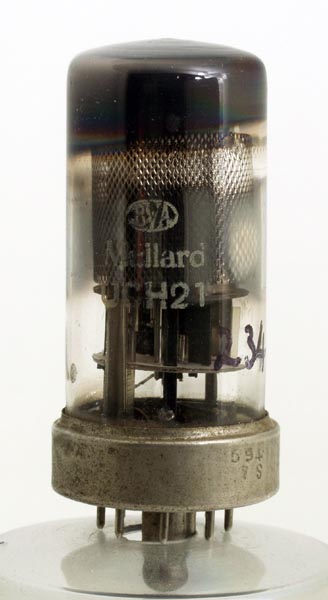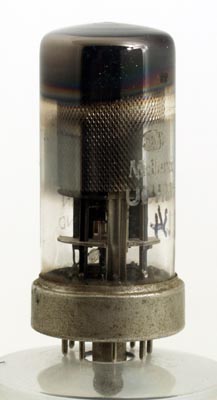
|
The UCH21 is an early example of all glass construction. This triode heptode frequency changer was designed to operate on a heater chain across the mains supply, and the anode voltage is correspondingly low to take account of the low HT voltage present in universal sets. Mullard describe the valve as designed to accept ACG to the heptode.The rusty metal skirt and the red paper band round it suggest that this is an early (1940s) sample. It looks as though it is of Continental manufacture rather than British, although Mullard did make UCH21's in the UK.Radiomuseum.org3002 give an introduction date of 1941 and indeed Sylvania had introduced the B8B base in 1939 in the US. The UK started making B8B based valves in 1948 and our data-sheet supports this. Thrower1043 does not list the UCH21, suggesting a post war introduction in the UK.The reason why there is no cathode/g5/s pin is that the metal spigot is used for this purpose. This meant that the metal skirt operated at cathode potential, not chassis potential, creating insulation problems unless a suitably-insulated base socket was used. It also creates problems with some commercial valve testers.On the whole the B8B (= Loctal) range of valves was not a long-term success, being knocked sideways by B7G and then annihilated by B9A before really gaining a market niche.
The electrode construction is obscured by the shielding screen. The triode is separate from the heptode and is required to generate a peak to peak voltage of 13 Volts to drive the mixer correctly.The wide glass tube envelope is 26 mm in diameter, and excluding the B8B base pins, is 62 mm tall.References: Data-sheet, private communication, 3002, 1040 & 1043. Type UCH21 was first introduced in 1941. See also 1941 adverts. |
Pin Connections
| 1 | 2 | 3 | 4 | 5 | 6 | 7 | 8 |  h | a | a(t) | g(t) | g2,g4 | g1 | g3 | h |
|
|
Absolute Maximum Operating Conditions¶
| Vh | Ah | Va | Vs | Vg | mAa | mAs | ra | gm | 
| 20.0 | 0.1 | 200 | 100 | -2 | 3.5 | 6.5 | 1M | 0.75 |
|
Absolute Maximum Operating Conditions¶
| Va | mAa | 
| 120 | 4.1 |
|
Updated February 07, 2013.
|
|